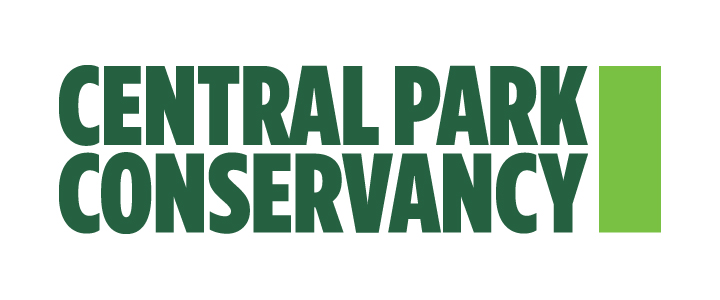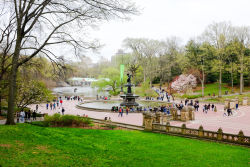Central Park
The Daily Plant : Friday, September 5, 2003
ASK PROFESSOR GINKGO: CASTLES AND CLASSROOMS
Dear Professor Ginkgo:
My friend from out of town and I went to see The Public Theater’s marvelous Central Park production of Henry 5—Liev Schreiber is such a hunk. Watching the performance in Delacorte Theater, we had a great view of Belvedere Castle. Maybe it was just the play that making me a little romantic, but I started wondering: was the castle really ever home to royalty—a Harry or a Richard, perhaps?
Well, dear reader, of course there never has been a King or Queen of New York—although several have vied for such a title. That being said, Belvedere Castle was never a home to anyone—except animals that is. Actually, early in Central Park’s lifetime, the Park’s designer and architect Calvert Vaux created an observation tower atop Vista Rock to overlook the old reservoir that is now the Great Lawn. The Gothic-style Castle was designed as a landmark for the pedestrian park visitor. Much of the structure was in fact constructed from the same type of schist as the Vista Rock which is why it appears to have been carved out of the actual rock itself. Its granite trim comes from a quarry in Quincy, Massachusetts and its roofs are made of colored slate from Vermont, Virginia, and New York.
Now as I’ve said, there are many small animals one can observe when they visiting the castle’s Henry Luce Nature Observatory, which includes interactive nature exhibits and bird-watching kits. But the castle’s most important resident isn’t alive at all. In fact, it’s weather reading equipment. That’s right. Whenever you read about the "temperature in Central Park," the weather being referred to is at the castle itself. Between 1869 and 1919, weather readings were taken from the Arsenal at 64th Street and Fifth Avenue. After 1919, the United States Weather Bureau moved the Central Park Observatory to the castle.
Dear Professor:
I’ve recently heard about a place called One Room Schoolhouse Park. Is there actually a schoolhouse there? If so, where do I enroll?
Well, I’m sorry to report that you’ve missed your chance to go to the one room schoolhouse. It was the last one of its kind in Queens until it was demolished to make a home for the park in 1934. The park was named under a local law in 1996. Compulsory school was first required by legislation in New York State in 1874. Five years later, in 1879, the one room schoolhouse opened. Last called P.S. 10, the school had also been known as the Bowery Bay School, for a school that was established in Steinway in 1734, and as a Frogtown School. The surrounding neighborhoods were largely rural and sparsely settled during the school's early existence. Many of the pupils were children of nearby farmers. The school was headed by Emma Fagan for thirty years. It had capacity for fifty-two students, divided into six classes, one for each year. The six rows of desks were arranged according to the age and ability of the students. The beginners were seated at the smaller desks in the front, while the more advanced students occupied the back rows.
By 1910, the one-room schoolhouse was considered antiquated in contrast to the public education system that was quickly expanding in more urban areas as a result of reform movements and to meet the needs of immigrants. Local concern was voiced that the school would be phased out in favor of a new institution in Corona. While the one-room schoolhouse was closed by 1925, a temporary school building was still in use at the time Parks & Recreation acquired the property from the Board of Education in 1934.
Fortunately, there are still plenty of great schools in New York City. I hope you will consider one of them instead.
BLOOD DRIVE CALLING ALL DONORS
Please join as at the Semi-Annual Blood Drive for employees who work in the three Arsenals, Manhattan Borough and the Central Park Conservancy. Help us to continue to save lives by being a donor.
The Blood Drive will be held Thursday, September 11, 2003 and Friday, September 12, 2003 from 8:30 a.m. - 1:45 p.m. at the Arsenal Gallery.
(*Employees who give a blood donation will receive three (3) hours Blood Compensatory Time)
For more information or to become a donor contact the following coordinators:
Hedi Piel - The Arsenal (212) 360-3442
Tarice Harris - Arsenal West (212) 830-7815
Luke Gebhard - Arsenal North (212)360-2776
Nadieg Jean - Cental Park Conservancy (212) 310-6635
Ben Kramer - Manhattan Boro (212) 408-0221
QUOTATION FOR THE DAY
"I seen my opportunities and I took ‘em."
George Washington Plunkitt
(1842-1924)
Check out your park's Vital Signs
Clean & Safe
Green & Resilient
Empowered & Engaged Users
Share your feedback or learn more about how this park is part of a
Vital Park System
Contacts
Central Park Information: (212) 310-6600
Central Park Information (for the Hearing Impaired): (800) 281-5722
Belvedere Castle, The Henry Luce Nature Observatory: (212) 772-0210
The Charles A. Dana Discovery Center: (212) 860-1370
The Dairy Visitor Center and Gift Shop: (212) 794-6564
North Meadow Recreation Center: (212) 348-4867
Loeb Boathouse (Bike rentals, boat rentals & gondolas): (212) 517-2233
Carousel: (212) 879-0244
Fishing at Harlem Meer (Catch & Release): (212) 860-1370
Harlem Meer Performance Festival: (212) 860-1370
Horseback Riding - Claremont Stables: (212) 724-5100
Metropolitan Opera (Performances on the Great Lawn): (212) 362-6000
New York Philharmonic (Performances on the Great Lawn): (212) 875-5709
Shakespeare in the Park - The Public Theater at the Delacorte Theater: (212) 539-8655
Central Park SummerStage: (212) 360-2777
Swedish Cottage Marionette Theater: (212) 988-9093
Tennis: (212) 280-0205
Weddings, Ceremonies and Photography at the Conservatory Garden: (212) 360-2766
Wildlife Center & Tisch Children's Zoo: (212) 439-6500











